B-h4-1BB/hTNFR2 mice plus
| Strain Name |
C57BL/6-Tnfrsf9tm1(TNFRSF9)BcgenTnfr2tm2(TNFR2)Bcgen/Bcgen
|
Common Name | B-h4-1BB/hTNFR2 mice plus |
| Background | C57BL/6 | Catalog number | 111958 |
|
Related Genes |
TNFRSF9:4-1BB, CD137, CDw137, ILA TNFR2: p75; TBPII; TNFBR; TNFR2; CD120b; TNFR1B; TNFR80; TNF-R75; p75TNFR; TNF-R-II |
||
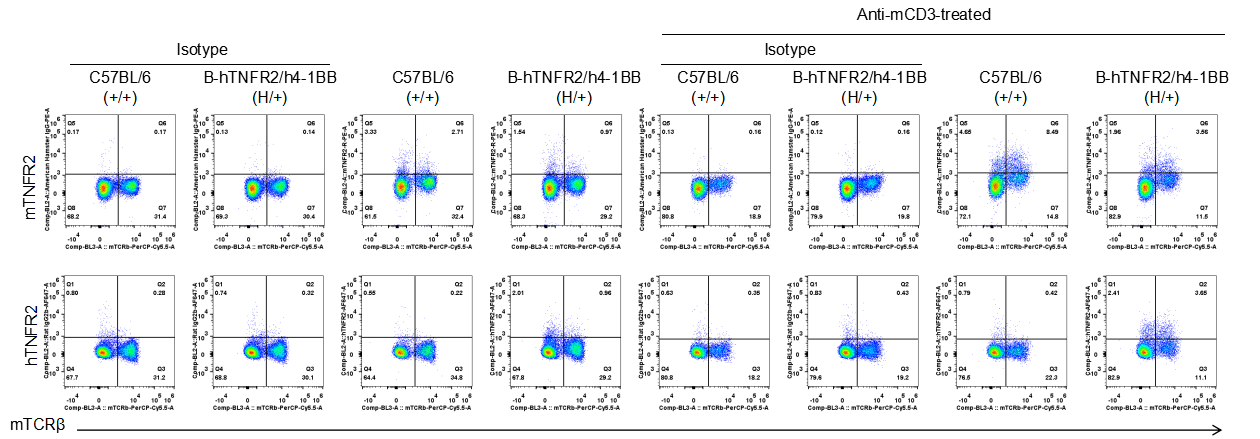
Strain specific TNFR2 expression analysis in heterozygous B-h4-1BB/hTNFR2 mice plus by flow cytometry. Splenocytes were collected from wild-type mice (+/+) and heterozygous B-h4-1BB/hTNFR2 mice plus (H/+) stimulated with anti-CD3ε in vivo (7.5 μg/mice, 24 hours, i.p.), and analyzed by flow cytometry with species-specific anti-TNFR2 antibody. Mouse TNFR2 was detectable in wild-type mice and heterozygous B-h4-1BB/hTNFR2 mice plus, but human TNFR2 was only detectable in heterozygous B-h4-1BB/hTNFR2 mice plus.
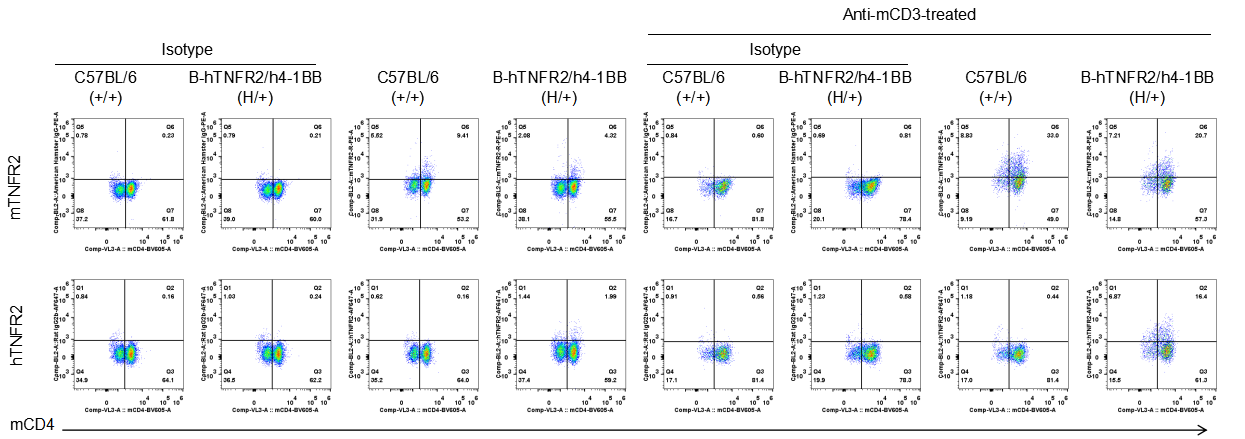
Strain specific TNFR2 expression analysis in heterozygous B-h4-1BB/hTNFR2 mice plus by flow cytometry. Splenocytes were collected from wild-type mice (+/+) and heterozygous B-h4-1BB/hTNFR2 mice plus (H/+) stimulated with anti-CD3ε in vivo (7.5 μg/mice, 24 hours, i.p.), and analyzed by flow cytometry with species-specific anti-TNFR2 antibody. Mouse TNFR2 was detectable in wild-type mice and heterozygous B-h4-1BB/hTNFR2 mice plus, but human TNFR2 was only detectable in heterozygous B-h4-1BB/hTNFR2 mice plus.
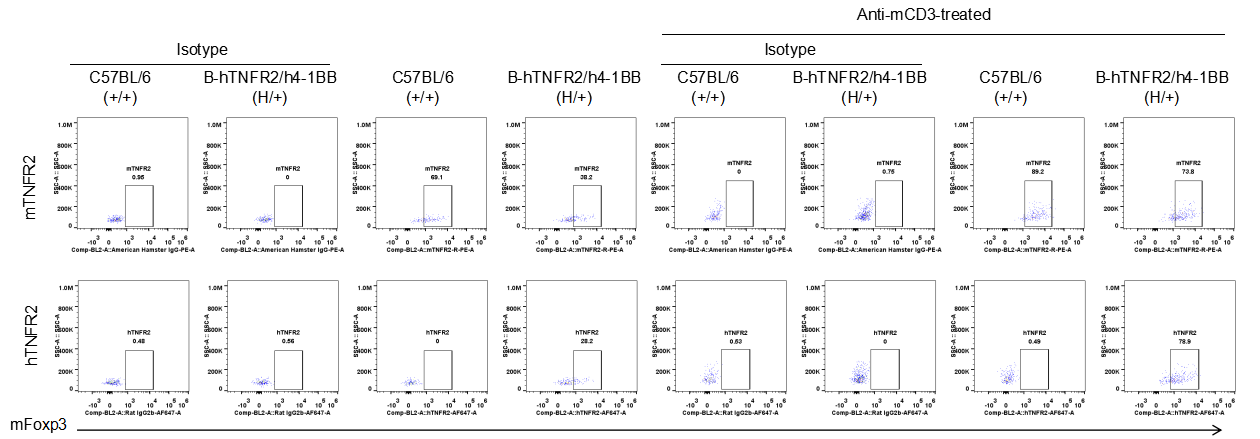
Strain specific TNFR2 expression analysis in heterozygous B-h4-1BB/hTNFR2 mice plus by flow cytometry. Splenocytes were collected from wild-type mice (+/+) and heterozygous B-h4-1BB/hTNFR2 mice plus (H/+) stimulated with anti-CD3ε in vivo (7.5 μg/mice, 24 hours, i.p.), and analyzed by flow cytometry with species-specific anti-TNFR2 antibody. Mouse TNFR2 was detectable in wild-type mice and heterozygous B-h4-1BB/hTNFR2 mice plus, but human TNFR2 was only detectable in heterozygous B-h4-1BB/hTNFR2 mice plus.
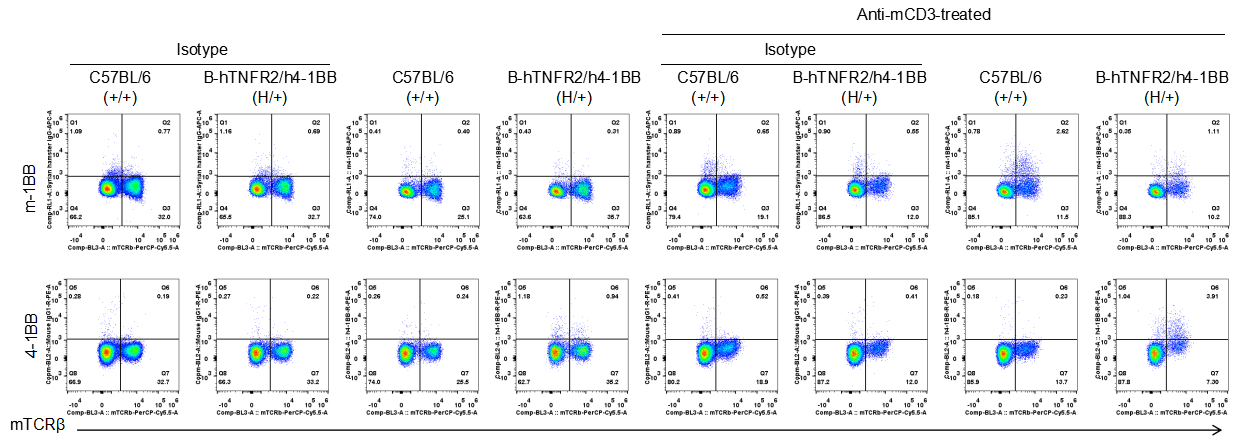
Strain specific 4-1BB expression analysis in heterozygous B-h4-1BB/hTNFR2 mice plus by flow cytometry. Splenocytes were collected from wild-type mice (+/+) and heterozygous B-h4-1BB/hTNFR2 mice plus (H/+) stimulated with anti-CD3ε in vivo (7.5 μg/mice, 24 hours, i.p.), and analyzed by flow cytometry with species-specific anti-4-1BB antibody. Mouse 4-1BB was detectable in wild-type mice and heterozygous B-h4-1BB/hTNFR2 mice plus, but human 4-1BB was only detectable in heterozygous B-h4-1BB/hTNFR2 mice plus.
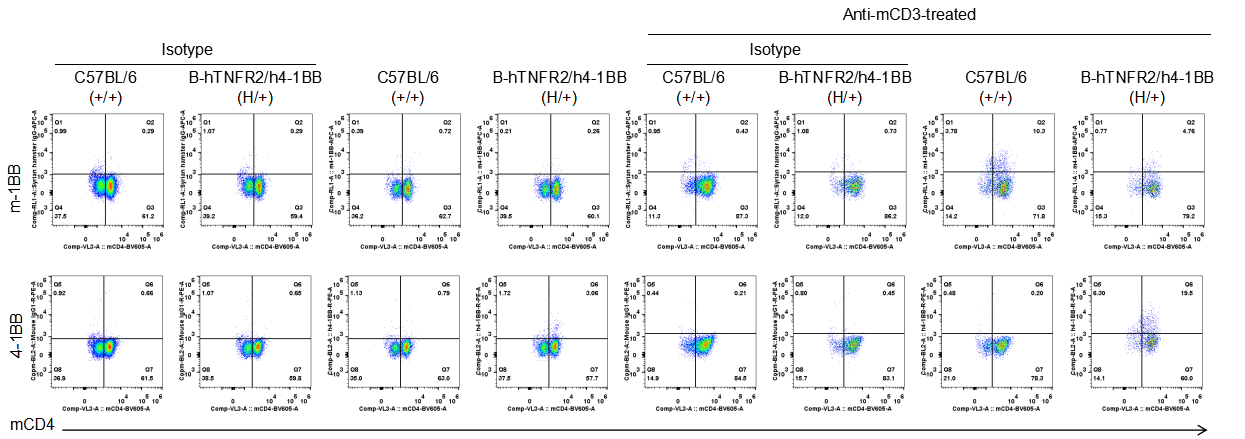
Strain specific 4-1BB expression analysis in heterozygous B-h4-1BB/hTNFR2 mice plus by flow cytometry. Splenocytes were collected from wild-type mice (+/+) and heterozygous B-h4-1BB/hTNFR2 mice plus (H/+) stimulated with anti-CD3ε in vivo (7.5 μg/mice, 24 hours, i.p.), and analyzed by flow cytometry with species-specific anti-4-1BB antibody. Mouse 4-1BB was detectable in wild-type mice and heterozygous B-h4-1BB/hTNFR2 mice plus, but human 4-1BB was only detectable in heterozygous B-h4-1BB/hTNFR2 mice plus.
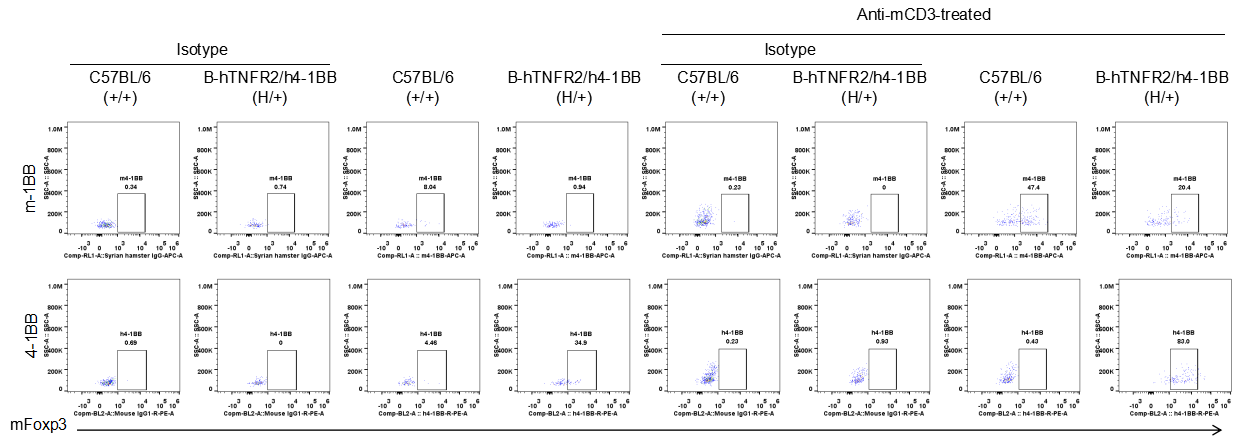
Strain specific 4-1BB expression analysis in heterozygous B-h4-1BB/hTNFR2 mice plus by flow cytometry. Splenocytes were collected from wild-type mice (+/+) and heterozygous B-h4-1BB/hTNFR2 mice plus (H/+) stimulated with anti-CD3ε in vivo (7.5 μg/mice, 24 hours, i.p.), and analyzed by flow cytometry with species-specific anti-4-1BB antibody. Mouse 4-1BB was detectable in wild-type mice and heterozygous B-h4-1BB/hTNFR2 mice plus, but human 4-1BB was only detectable in heterozygous B-h4-1BB/hTNFR2 mice plus.
Tumor growth curve & Body weight changes

Subcutaneous homograft tumor growth of MC38 cells in homozygous B-h4-1BB/hTNFR2 mice plus. Wild-type MC38 cells (5x105) were subcutaneously implanted into B-h4-1BB/hTNFR2 mice plus (female, 8-week-old, n=6). Tumor volume and body weight were measured twice a week. (A) Average tumor volume ± SEM. (B) Body weight (Mean± SEM). (C) Tumor growth curve of individual mice. Volume was expressed in mm3 using the formula: V=0.5 X long diameter X short diameter2. As shown in panel A, MC38 cells were able to establish tumors in vivo and can be used for efficacy studies.












 京公网安备:
京公网安备: